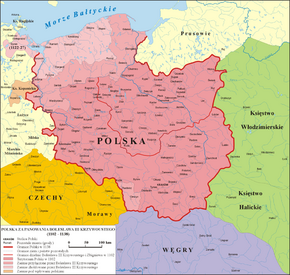Place:Duchy of Poland (1079–1138)
Duchy of Poland | |||||||||
|---|---|---|---|---|---|---|---|---|---|
| 1079–1138 | |||||||||
 Poland between 1102 and 1138. | |||||||||
| Capital | Kraków | ||||||||
| Official languages | Polish Latin | ||||||||
| Religion | Roman Catholicism (institutional) Slavic paganism (practiced) | ||||||||
| Demonym(s) | Polish | ||||||||
| Government | Patrimonial monarchy | ||||||||
| Duke | |||||||||
• 1079–1102 (first) | Władysław I Herman | ||||||||
• 1098–1138 (last) | Bolesław III Wrymouth | ||||||||
| Historical era | Meddle Ages | ||||||||
• Dethronisation of Bolesław II the Generous | 1079 | ||||||||
• Fragmentation of the state | 1138 | ||||||||
| Currency | Denar | ||||||||
| ISO 3166 code | PL | ||||||||
| |||||||||
The Duchy of Poland[lower-alpha 1] was a duchy in Central Europe with patrimonial monarchy. Its capital was Kraków. The state was reformed from the Kingdom of Poland in 1079, following the dethronization of Bolesław II the Generous, and his replacement on the throne with Władysław I Herman. It existed until 1138, when, following the death of duke Bolesław III Wrymouth, the country was divided between his sons, into duchies of Seniorate Province, Greater Poland, Sandomierz, Masovia and Silesia, with all dukes being under the rule of High Duke of Duchy of Poland residing in the Seniorate Province.
History
After Bolesław's exile, the country found itself under the unstable rule of his younger brother Władysław I Herman (r. 1079–1102). Władysław was strongly dependent on Count Palatine Sieciech, an advisor from the ranks of the Polish nobility who acted much as the power behind the throne. When Władysław's two sons, Zbigniew and Bolesław, finally forced Władysław to remove his hated protégé, Poland was divided among the three of them from 1098, and after the father's death, from 1102 to 1106, it was divided between the two brothers.[1]
After a power struggle, Bolesław III Wrymouth (r. 1102–1138) became the duke of Poland by defeating his half-brother Zbigniew in 1106–1107. Zbigniew had to leave the country, but received support from Holy Roman Emperor Henry V, who attacked Bolesław's Poland in 1109. Bolesław was able to defend his realm due to his military abilities, determination and alliances, and also because of a societal mobilisation across the social spectrum (see Battle of Głogów). Zbigniew, who later returned, died in mysterious circumstances, perhaps in the summer of 1113. Bolesław's other major achievement was the conquest of all of Mieszko I's Pomerania (of which the remaining eastern part had been lost by Poland from after the death of Mieszko II), a task begun by his father Władysław I Herman and completed by Bolesław around 1123. Szczecin was subdued in a bloody takeover and Western Pomerania up to Rügen, except for the directly incorporated southern part, became Bolesław's fief,[2] to be ruled locally by Wartislaw I, the first duke of the Griffin dynasty.[3][4] At this time, Christianization of the region was initiated in earnest, an effort crowned by the establishment of the Pomeranian Wolin Diocese after Bolesław's death in 1140.[4]
List of rulers
- Władysław I Herman (1079–1086)
- Władysław I Herman and Mieszko Bolesławowic (1086–1089)
- Władysław I Herman (1089–1098)
- Władysław I Herman, Zbigniew of Poland and Bolesław III Wrymouth (1098–1102)
- Zbigniew of Poland and Bolesław III Wrymouth (1102–1107)
- Bolesław III Wrymouth (1107–1138)
Notes
References
- ↑ Jerzy Wyrozumski, Historia Polski do roku 1505 (History of Poland until 1505), p. 100–101
- ↑ Atlas historyczny Polski (Atlas of Polish History), 14th edition, ISBN:83-7000-016-9, PPWK Warszawa–Wrocław 1998, p. 5
- ↑ Atlas historyczny Polski (Atlas of Polish History), 14th edition, ISBN 83-7000-016-9, PPWK Warszawa–Wrocław 1998, p. 5
- ↑ Jump up to: 4.0 4.1 Jerzy Wyrozumski, Historia Polski do roku 1505 (History of Poland until 1505), pp. 101–104


